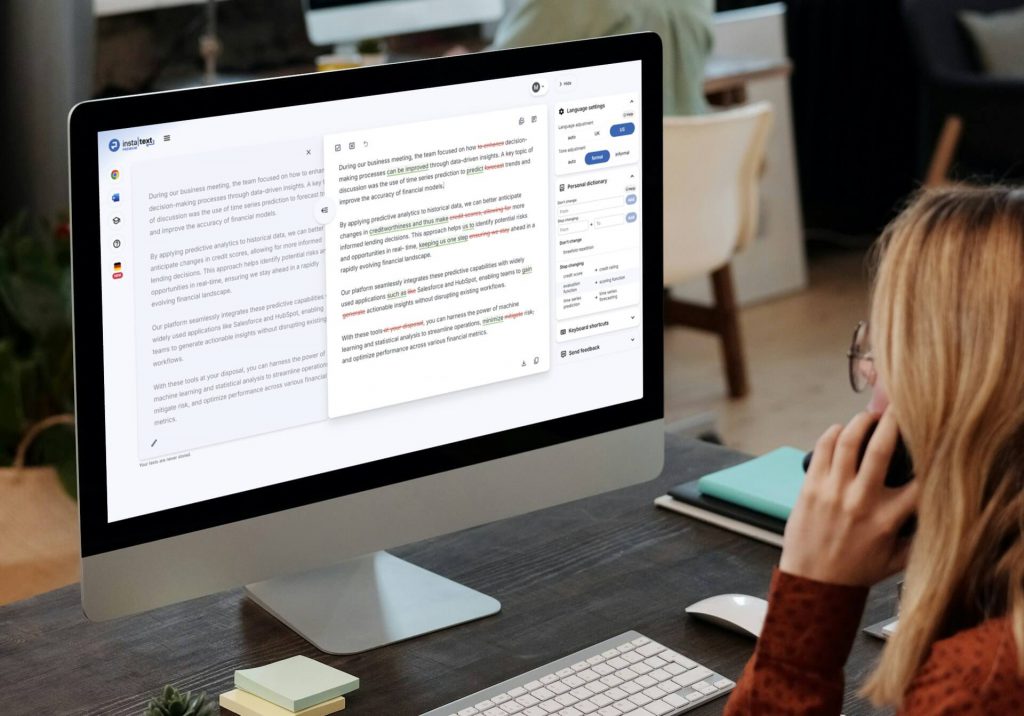You may have heard terms such as “readability,” “readability checkers,” and “readability scores” in the context of academic writing, and you may have come across research showing that the more readable a paper is, the higher its acceptance rates and citation counts tend to be.
But what is “readability”? Why is it important? And do you need to know all the different readability formulas—which sometimes sound complicated and overwhelming—to write a successful academic paper?
In this article, we’ll answer all these questions, give you tips on how to make your work more readable, and show you how to use InstaText to improve the readability of your texts so you can achieve the results you want. Let’s dive in.

What is readability?
Readability is a measure of how easy or difficult it is to read and understand a text. In other words, readability is not just about making content easy to read—it’s about ensuring that important information is accessible, understandable, and usable.
Why is readability important?
In general, making your work readable helps you connect with your target audience and attract more readers. In academic writing in particular, research shows that readability helps authors:
Improve review outcomes
Manuscripts that are difficult to understand run the risk of being rejected during the review process, as editors and reviewers may have difficulty understanding the content.
Keep the focus on your message
Poor readability can undermine the focus and message of your work and reduce the chances of publication.
Enhance research impact
Clear writing makes research findings accessible to a wider audience, increasing their impact on policymakers, market participants, charitable donors, etc.
Meet accreditation standards
Universities now assess the impact of research, not just the quantity of publications. To be influential, it is important how the information is disseminated.
Improve reader engagement and discoverability
Good readability engages the reader and enhances the discoverability of your work.
Increase citations
Unreadable papers tend to receive fewer citations.
Maintain credibility
Poor readability can create a negative impression that reduces the perceived quality of the work and undermines its effectiveness in conveying important information.

What is a readability score?
A readability score indicates the level of education required to easily understand a text. For example, the average reading level of adults in the United States is eighth grade.
How can I check the readability score of my writing?
You can measure readability using formulas that calculate the grade level required to understand a text. The Flesch-Kincaid Grade Level, the Gunning Fog Index, the Dale-Chall Readability Grade, and the Automated Readability Index are classic formulas for measuring readability. Modern tools such as Hemingway Editor offer online readability checkers that improve on these traditional formulas.
How reliable are readability scores?
Although readability tools and scores can be useful indicators, they have their limitations, according to experts. For academic texts in particular, it can be misleading to rely solely on readability scores, as there are various other factors that influence the readability of a text.

Tips for enhancing readability
Now that we know the characteristics of a readable paper and that we can’t rely solely on readability tools and scores, we can use best academic writing practices to make our work easier to read and understand. Below are some tips and examples that you may find useful.
1- Use clear and simple language
Avoid using complicated words or phrases when simpler alternatives work just as well. Academic texts don’t need to sound complicated. They need to be clear.
Example:
- Complicated: “The application of contemporary techniques is crucial for enhancing analytical results.”
- Clear: “Using modern techniques is important for improving analysis.”

See also: How InstaText makes your writing sound more natural
2- Be specific
Vague language can confuse your readers. Always try to be as specific as possible and give examples to illustrate your points.
Example:
- Vague: “Some experts argue that online learning is less effective.”
- Specific: “A 2022 study by Alexander Johnson found that students in online courses scored 15% lower on average than those in traditional classrooms.”
3- Use active voice
Active voice makes your text more direct, dynamic, and easier to follow. It helps clarify who is performing which action.
Example:
- Passive: “The results were analysed.”
- Active: “The team analysed the results.”
4- Make your sentences easy to follow
Mix short and long sentences to keep your text engaging and clear. A variety of sentence lengths ensures a natural flow.
Example:
- Monotonous: “We reviewed the data for three days. Then we analysed the information. We found some interesting patterns.”
- Engaging: “After three days of reviewing the data, we analysed it and discovered interesting patterns.”

See also: Avoid reader fatigue: Keep readers engaged with InstaText
5- Organise your paragraphs well
Begin each paragraph with a clear sentence that contains the main point. This sets the tone and direction for the rest of the paragraph.
Example:
- Weak: “There were patterns found in the results. The data also suggested some changes in trends.”
- Strong: “The data showed clear patterns, indicating changes in trends.”
6- Use transitions for smooth flow
Transitions guide the reader from one idea to the next and help maintain the flow of your text. They create a logical connection between sentences and paragraphs.
Example:
- Without transition: “The team collected data for three months. The analysis revealed significant trends.”
- With transition: “After collecting data for three months, the team’s analysis revealed significant trends.”

See also: How InstaText helps non-native speakers overcome common writing challenges
7- Use headings and lists to improve structure
Headings help organise your content and make it easier to skim. Lists organise the information so that it is easy to digest.
8- Include visuals to support your ideas
Visual elements such as graphs and charts help make complex information clearer. They break up the text and help the reader better understand your statements.
9- Take time to edit and proofread
Editing plays an important role in refining your work by improving its structure, flow, style, and more. Proofreading ensures that the final version is polished. Remember to take breaks between editing and proofreading to make it easier to spot errors.
See also: Why you should draft, edit, and proofread separately
10- Use helpful tools
Tools such as editing assistants can help you refine your work, while citation tools help you organise and format references.
How InstaText makes your work more readable
As mentioned earlier, proper editing of your work can increase readability and help you achieve your goal, whether it’s to get published in a journal, inform readers, influence policy, or persuade an audience.
InstaText is an advanced editing assistant that can help you make your texts more readable while meeting the strict originality and authorship criteria of academic platforms.

See also: Why InstaText is your best bet for getting published
Let’s take a closer look at how InstaText supports your academic writing efforts:
Refining your texts
InstaText improves your texts by enhancing clarity, flow, structure, style, tone, conciseness, word choice, grammar, spelling, punctuation, and more during the editing and proofreading process. It also makes your editing process more efficient and faster, without compromising on quality, so you can meet tight deadlines.

Maintaining originality and authorship
InstaText is ideal for academic contexts with strict criteria for authorship and originality, where the use of generative AI is prohibited or restricted. This is because InstaText uses advanced language technologies, but not generative AI. This means that, unlike ChatGPT, for example, it does not generate content, but improves existing content. The edits are therefore not AI-generated.

See also: Why InstaText edits are not AI-generated
Are you ready to increase the reach and impact of your work with InstaText? If you’re a user, we recommend you take a look at InstaText’s features and our blog to get the most out of InstaText.

If you’re not a user yet, you can try it out for free and see if it can be a cost-effective alternative to hiring a human editor, which can be both expensive and time-consuming. Also take a look at our InstaText One for Team plan, which has been specially developed for teams and enables you and your colleagues to work together on scientific projects!
“I find InstaText very helpful. It makes me much faster in writing papers. I’m a perfectionist and usually spend (way too) much time finding the right words and making sure that sentences are easily readable even if the concepts are arbitrarily complicated. InstaText makes my life easier. I recommend it to any PhD student or researcher, whether a native English speaker or not.”
— Giulia Guidi, PhD Student, University of California, Berkeley
“InstaText makes your text engaging to read, coherent, and professional-looking. Further, I feel that paragraphs corrected by InstaText look akin to what I see in top marketing and social psychology journals. It is a huge help for an academic writer because rather than focusing on making the text appealing, you can simply focus on what you want to say and build a logically unfolding narration.”
— Dr. Michał Folwarczny, Postdoctoral Researcher
“InstaText is a great tool! I use it to improve English texts such as articles, projects and abstracts for conferences. The tool provides very useful suggestions that help me to translate the text to a professional level so that no additional review by “native speakers” is required. The time and money savings are obvious. I highly recommend it!”
— Dr. Janez Konc, Senior Researcher


